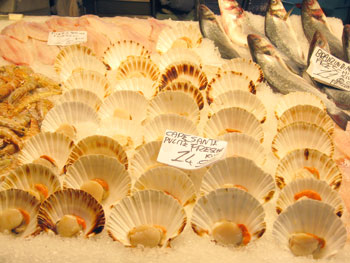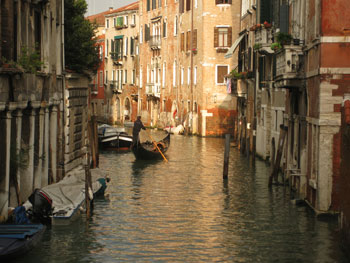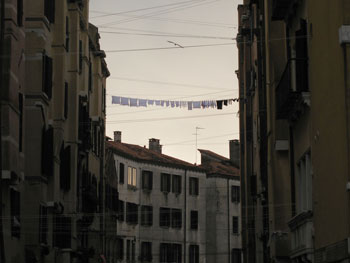 Flying by the seat of one’s (lone pair of) pants took on a whole new meaning last Christmas. After 25 hours of lengthy plane detours, we arrived luggageless in Rome to then board a packed train bound for Venice. Though weary and grimy from running to various gates, we found our lighter load fared us well. In the cramped quarters of the train’s cabin, we attempted to stave our hunger pains with shared visions of creamy risotto and Chianti.
Flying by the seat of one’s (lone pair of) pants took on a whole new meaning last Christmas. After 25 hours of lengthy plane detours, we arrived luggageless in Rome to then board a packed train bound for Venice. Though weary and grimy from running to various gates, we found our lighter load fared us well. In the cramped quarters of the train’s cabin, we attempted to stave our hunger pains with shared visions of creamy risotto and Chianti.
Venezia was experiencing exorbitantly high floods this particular winter. While our hotel was just half a mile from the Sante Lucia rail station, we quickly noticed how useful thigh-high rubber boots could be. Assured that our lost belongings would soon be catching up with us, we decided to embrace the ensuing downpour.
The brightly-lit, colorful alleyways boasted shops teeming with hand-painted Carnivale masks, warmed pistachio pastries, elegant dresses and trinkets of vibrant glass. We dodged the cavernous puddles and watery nooks where it was possible but soon found ourselves drenched to the knees. Heavy sandbags, glass door gates and bolstered wooden planks did not provide much relief for the few winter stragglers.
 Since it was mid-afternoon, we decided to stop for some cichetti and gelato so that we could splurge on a bigger meal later in the day. Following a tip from a friendly native, we bypassed anything with more than ten tables, a second menu in English, or groups of poncho-clad tourists wearing yellow plastic bags. (A judgment we would later retract that night as we—still without suitcases–scrubbed out saturated shoes in the hotel’s washbasin.) On our outing, we planned to stroll through the renowned fish market, Piazza San Marco and check out the slew of famous galleries. It was easier to concentrate, of course, once satiated.
Since it was mid-afternoon, we decided to stop for some cichetti and gelato so that we could splurge on a bigger meal later in the day. Following a tip from a friendly native, we bypassed anything with more than ten tables, a second menu in English, or groups of poncho-clad tourists wearing yellow plastic bags. (A judgment we would later retract that night as we—still without suitcases–scrubbed out saturated shoes in the hotel’s washbasin.) On our outing, we planned to stroll through the renowned fish market, Piazza San Marco and check out the slew of famous galleries. It was easier to concentrate, of course, once satiated.
Festooned with twinkling turquoise lights, the main shopping area of Ruga dei Ciresi was festive and surprisingly hectic. Swarming with visitors sprouting wind-bruised umbrellas, the waterlogged, narrow corridors required shared humor, skill and dexterity.
We stopped to admire the senescent San Giacomo church, consecrated in the year 421, before squeezing our way into the flocks perched atop the Ponte Rialto. Below us sleek columns of gondolas were shelved like skates for February’s cavalcade; their svelte, curled frames docked between posts of petrified wood. Traghetti, water taxis and misted dinghies drifted through the opaque Grand Canal, their steady hum broken only by the clanging of church bells. These muted waterways were a stark contrast to the honking horns, buzzing vespas and congested streets in the rival cities of Florence and Rome.
The covered pescaria offered some relief from the deluge as we shook out our soaked hats and parkas. We wandered up and down the aisles of vendors, inhaling the moist, redolent blend of cigar smoke and unfamiliar languages uttered breathlessly in intense negotiation. The diving, squawking seagulls bickered endlessly for handouts: carved scallops, gleaming swordfish, sculpted piles of clams and hard-shelled thorny crab. It was amazing to think that their winged ancestors had been squabbling in this same place since 1300.
 After hours of perusing tapestries, relics, and paintings, the sun finally burnt off the clouds. At last we could venture to one of the further areas! Nestled in the Adriatic Sea, Venice is made up of six sestiere, or smaller districts: Cannaregio, San Polo, Dorsoduro, Santa Croce, San Marco and Castello; there are 118 islands in the archipelago, 409 bridges and 150 canals. We had a lot of ground to explore and hoped the warm sunshine would dry out our sopped clothes. It was apparent that the locals were also taking advantage of the sun break. A patchwork of freshly laundered garments waved above us in the breeze, strung between buildings with rain still spiraling in rivulets from the overhangs.
After hours of perusing tapestries, relics, and paintings, the sun finally burnt off the clouds. At last we could venture to one of the further areas! Nestled in the Adriatic Sea, Venice is made up of six sestiere, or smaller districts: Cannaregio, San Polo, Dorsoduro, Santa Croce, San Marco and Castello; there are 118 islands in the archipelago, 409 bridges and 150 canals. We had a lot of ground to explore and hoped the warm sunshine would dry out our sopped clothes. It was apparent that the locals were also taking advantage of the sun break. A patchwork of freshly laundered garments waved above us in the breeze, strung between buildings with rain still spiraling in rivulets from the overhangs.
In our new leisure, we missed the chance to see the coveted Peggy Guggenheim collection, so we headed north instead to watch the sunset at Saint Mark’s Square. San Marco was a giant knee-deep pool of purple at twilight: its winking lamps and stars like tiny pinprick holes in the crimson velvet sky. The majestic silhouette of the basilica loomed before us with its darkened antique Baroque windows and bulbous domes. Fat, nosy pigeons fluttered aimlessly over the stone lions guarding the massive structure. We stood in awe of the architectural synthesis– Doge’s palace, the gothic-spired campanile, the 500-year-old clock tower, where a pregnant moon was displayed in the present sign of Capricorn. At dusk the gleaming marble columns of the Procuratie offices offset their darkened arches, encircling us like a giant ivory keyboard.
As the shadows lengthened, we navigated the endless mazes of Dorsoduro in our quest for the quintessential candlelit restaurant. (We now know, however, that this stands to be corrected as an American myth. Italians, even in the romantic city of Venice, seem to prefer to adequately see their food.) The twists and turns in the yawning shadows after sundown pushed us deep into the former red light district. We dined at a trendy brothel-turned-bistro on savory mussels marinated in garlic, inky cuttlefish vermicelli and toasted baguettes dipped in olive oil. Our affable neighbors at the next table shared tips for our trip to Slovenia before recommending we finish the meal together with a rich, smooth grappa and a toast.
Warmed from the drink and intimate conversation, we thought we’d amble in search of an after-dinner macchiato. By this time night had fallen, however, and the labyrinth of desolate streets was harder to retrace by moonlight. Passageways abruptly ended, busy thoroughfares were deserted; courtyards seemed foreboding in their emptiness. It was eerily quiet–just the ubiquitous lapping of swollen canals. Many of the young merchants commute from the mainland and the flats around us had closed their dark shutters, eclipsing the soft evening warmth of their private homes. The City of Light had apparently shut down completely–the only illumination came from hung lampposts that flickered dimly in the fog.
A fastidious nocturnal clean-up had already begun, however. Here and there small crews were out sweeping the wet, uneven cobblestone; picking up small bags of trash left just outside ground level doors. The fountains were stilled and clogged with the afternoon’s leaves; graffiti-coated gates secured most of the storefronts. As we tried to get our bearings, withered tree skeletons squeaked in the wind, pointing us onward and reaching out to us with their spindly arms.
Our meanderings became more frenzied when we heard the sharp tapping of unseen boot heels behind us. We re-crossed bridges, blew on chilled hands, and cursed our clinging pants and sodden shoes. The headless distended torsos of shirts forgotten on the lines now beckoned and flailed in the wind. The shivers that danced up our backs were evenly sired by Jack-the–Ripper alcoves, and not knowing if our deft followers had sinister intentions.
A pocket of liveliness opened before us in San Polo, where we seized the opportunity to warm ourselves with a nightcap before an open fire. Lodged in an out-of-the-way cranny near Campo de la Lana Street, this tavern was packed with jovial, inebriated youth swaying to blasting music. It was reassuring to be smooshed in close to people again and suddenly easy to imagine the jammed channels, stuffy cafes and boisterous atmosphere in the stretch of humid summer months. On our way back to the hotel we left two roses plucked from our table in one of the many random religious wall urns.
We were exhausted from walking all day but somehow lighter in our bulky clothes, cold and chapped, slaked yet hungry for more. It was by some means fitting that our luggage still hadn’t arrived; we wouldn’t be able to exchange our soiled sweaters, and our shoes were definitely ruined.
 We realized that Venice is a strange fusion of ancient and modern elegance combined with brazen, crumbling decay. Its magnificent churches, lavish festivals and rich art circuit are contrasted with faded, decrepit buildings, polluted, lifeless canals and the fragile, submerged lagoon. Its citizens are stylishly dressed in the latest fashions, but can barely afford to upkeep their rotting, sinking homes. Over 15 million globetrotters visit each year, bringing in thousands of dollars in revenue for their dependent economy. These vacationers, however, also contribute to high amounts of civilian dumping, and loss of flora and wildlife due to the chemicals from boats.
We realized that Venice is a strange fusion of ancient and modern elegance combined with brazen, crumbling decay. Its magnificent churches, lavish festivals and rich art circuit are contrasted with faded, decrepit buildings, polluted, lifeless canals and the fragile, submerged lagoon. Its citizens are stylishly dressed in the latest fashions, but can barely afford to upkeep their rotting, sinking homes. Over 15 million globetrotters visit each year, bringing in thousands of dollars in revenue for their dependent economy. These vacationers, however, also contribute to high amounts of civilian dumping, and loss of flora and wildlife due to the chemicals from boats.
The mythical and religious symbols of hope in Venice are unmatched globally, however. They span across cultures and decades and aren’t necessarily rooted in one denomination. The posh costumed processions, decadent cuisine and expensive apparel breed an atmosphere of magic and mystery that are bewitching regardless of circumstance. People come here to celebrate something in a city that now welcomes refulgence and expect that no matter what they will at least be charmed.
Hot, cold, luggageless–travelers are away from the rest of the world in a beguiling fairytale city that floats. A place that is defying odds and enchanting in its timeworn and time-tested grandeur. Maybe because people know that it won’t last forever they are more easily seduced, more forgiving of mishaps and discomforts, of places where the fantasies don’t necessarily reach the masked reality. They see instead that they are a part of something historically significant and reduced, and decide that beauty really is ephemeral, elusive and impossible to capture and preserve. They need to completely immerse themselves in the mixed splendor for at least a short time so that they can both validate it and sneak just a little bit of it home.